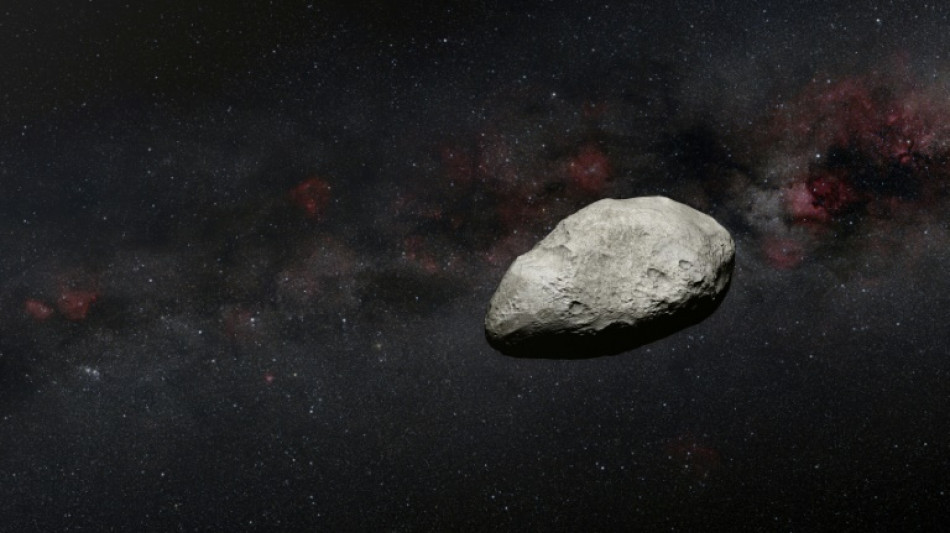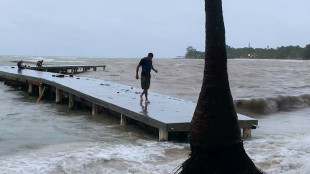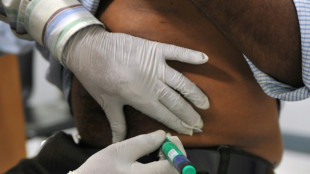
-
 Markets struggle at end of tough week
Markets struggle at end of tough week
-
China tests building Moon base with lunar soil bricks

-
 Film's 'search for Palestine' takes centre stage at Cairo festival
Film's 'search for Palestine' takes centre stage at Cairo festival
-
Oil execs work COP29 as NGOs slam lobbyist presence

-
 Gore says climate progress 'won't slow much' because of Trump
Gore says climate progress 'won't slow much' because of Trump
-
'Megaquake' warning hits Japan's growth

-
 Stiff business: Berlin startup will freeze your corpse for monthly fee
Stiff business: Berlin startup will freeze your corpse for monthly fee
-
Wars, looming Trump reign set to dominate G20 summit

-
 Xi, Biden attend Asia-Pacific summit, prepare to meet
Xi, Biden attend Asia-Pacific summit, prepare to meet
-
Kyrgios to make competitive return at Brisbane next month after injuries

-
 Dominican Juan Luis Guerra triumphs at 25th annual Latin Grammys
Dominican Juan Luis Guerra triumphs at 25th annual Latin Grammys
-
Landslide win for Sri Lanka president's leftist coalition in snap polls

-
 Australian World Cup penalty hero Vine takes mental health break
Australian World Cup penalty hero Vine takes mental health break
-
As Philippines picks up from Usagi, a fresh storm bears down

-
 Tropical Storm Sara pounds Honduras with heavy rain
Tropical Storm Sara pounds Honduras with heavy rain
-
Pepi gives Pochettino win for USA in Jamaica

-
 'Hell to heaven' as China reignite World Cup hopes with late winner
'Hell to heaven' as China reignite World Cup hopes with late winner
-
Rebel attacks keep Indian-run Kashmir on the boil

-
 New Zealand challenge 'immense but fantastic' for France
New Zealand challenge 'immense but fantastic' for France
-
Under pressure England boss Borthwick in Springboks' spotlight

-
 All Blacks plan to nullify 'freakish' Dupont, says Lienert-Brown
All Blacks plan to nullify 'freakish' Dupont, says Lienert-Brown
-
TikTok makes AI driven ad tool available globally

-
 Japan growth slows as new PM readies stimulus
Japan growth slows as new PM readies stimulus
-
China retail sales pick up speed, beat forecasts in October

-
 Asian markets fluctuate at end of tough week
Asian markets fluctuate at end of tough week
-
Gay, trans people voicing -- and sometimes screaming -- Trump concerns

-
 Argentina fall in Paraguay, Brazil held in Venezuela
Argentina fall in Paraguay, Brazil held in Venezuela
-
N. Korean leader orders 'mass production' of attack drones

-
 Pakistan's policies hazy as it fights smog
Pakistan's policies hazy as it fights smog
-
Nature pays price for war in Israel's north

-
 New Zealand's prolific Williamson back for England Test series
New Zealand's prolific Williamson back for England Test series
-
Mexico City youth grapple with growing housing crisis

-
 After Trump's victory, US election falsehoods shift left
After Trump's victory, US election falsehoods shift left
-
Cracks deepen in Canada's pro-immigration 'consensus'

-
 Xi inaugurates South America's first Chinese-funded port in Peru
Xi inaugurates South America's first Chinese-funded port in Peru
-
Tyson slaps Paul in final face-off before Netflix bout

-
 England wrap-up T20 series win over West Indies
England wrap-up T20 series win over West Indies
-
Stewards intervene to stop Israel, France football fans clash at Paris match

-
 Special counsel hits pause on Trump documents case
Special counsel hits pause on Trump documents case
-
Japan's Princess Mikasa, great aunt to emperor, dies aged 101

-
 Cricket at 2028 Olympics could be held outside Los Angeles
Cricket at 2028 Olympics could be held outside Los Angeles
-
Trump names vaccine skeptic RFK Jr. to head health dept

-
 Ye claims 'Jews' controlling Kardashian clan: lawsuit
Ye claims 'Jews' controlling Kardashian clan: lawsuit
-
Japan into BJK Cup quarter-finals as Slovakia stun USA

-
 Sri Lanka president's party headed for landslide: early results
Sri Lanka president's party headed for landslide: early results
-
Olympics 'above politics' say LA 2028 organisers after Trump win

-
 Panic strikes Port-au-Prince as residents flee gang violence
Panic strikes Port-au-Prince as residents flee gang violence
-
Carsley hails England's strength in depth as understudies sink Greece

-
 Undefeated Chiefs lose kicker Butker to knee injury
Undefeated Chiefs lose kicker Butker to knee injury
-
Wallabies winger Vunivalu signs for La Rochelle

| RBGPF | 100% | 61.84 | $ | |
| RYCEF | -4.71% | 6.79 | $ | |
| CMSC | -0.24% | 24.55 | $ | |
| NGG | 0.4% | 62.37 | $ | |
| BCC | -1.57% | 140.35 | $ | |
| GSK | -2.09% | 34.39 | $ | |
| RIO | -0.31% | 60.43 | $ | |
| CMSD | -0.02% | 24.725 | $ | |
| AZN | -0.38% | 65.04 | $ | |
| SCS | -0.75% | 13.27 | $ | |
| RELX | -0.37% | 45.95 | $ | |
| JRI | -0.23% | 13.21 | $ | |
| BP | 1.65% | 29.05 | $ | |
| VOD | -0.81% | 8.68 | $ | |
| BCE | -1.38% | 26.84 | $ | |
| BTI | 0.2% | 35.49 | $ |

Nuking a huge asteroid could save Earth, lab experiment suggests
Humanity could use a nuclear bomb to deflect a massive, life-threatening asteroid hurtling towards Earth in the future, according to scientists who tested the theory in the labaratory by blasting X-rays at a marble-sized "mock asteroid".
The biggest real-life test of our planetary defences was carried out in 2022, when NASA's fridge-sized DART spacecraft smashed into a 160-metre (525-feet) wide asteroid, successfully knocking it well off course.
But for bigger asteroids, merely crashing spaceships into them will probably not do the trick.
When the roughly 10-kilometre wide Chicxulub asteroid struck the Yucatan peninsula around 66 million years ago, it is believed to have plunged Earth into darkness, sent kilometres-high tsunamis rippling around the globe and killed three quarters of all life -- including wiping out the dinosaurs.
We humans are hoping to avoid a similar fate.
There is no current threat looming, but scientists have been working on how to stave off any big asteroids that could come our way in the future.
A leading theory has been to be blow them up with a nuclear bomb -- a last-ditch plan famously depicted in the 1998 sci-fi action movie "Armageddon".
In the movie, Bruce Willis and a plucky team of drillers save Earth from an asteroid 1,000 kilometres wide -- roughly the size of Texas.
For a proof-of-concept study published in the journal Nature Physics this week, a team of US scientists worked on a much smaller scale, taking aim at a mock asteroid just 12 millimetres (half an inch) wide.
To test whether the theory would work, they used what was billed as the world's largest X-ray machine at Sandia National Laboratories in Albuquerque, New Mexico.
The machine is capable of generating "the brightest flash of X-rays in the world using 80 trillion watts of electricity", Sandia's Nathan Moore, the lead study author, told AFP.
Much of the energy created by a nuclear explosion is in the form of X-rays. Since there is no air in space, there would be no shockwave or fireball.
But the X-rays still pack a powerful punch.
- Turned into a 'rocket engine' -
For the lab experiment, the X-rays easily vaporised the surface of the mock asteroid.
The vaporising material then propelled the mock asteroid in the opposite direction, so that it effectively "turned into a rocket engine," Moore said.
It reached speeds of 250 kilometres an hour, "about as fast as a high-speed train," he added.
The test marked the first time that predictions about how X-rays would affect an asteroid had been confirmed, Moore said.
"It really proves this concept could work."
The scientists used modelling to scale up their experiment, estimating that X-rays from a nuclear blast could deflect an asteroid up to four kilometres wide -- if given enough advanced notice.
The biggest asteroids are the easiest to detect ahead of time, so "this approach could be quite viable" even for asteroids the size of the dinosaur-killing Chicxulub, Moore said.
The experiment was based on using a one-megaton nuclear weapon. The largest ever detonated was the 50-megaton Soviet Tsar Bomba.
If there was to be a planet-saving mission in the future, the nuclear bomb would need to be placed within a few kilometres of the asteroid -- and millions of kilometres away from Earth, Moore said.
- Asteroids come in many flavours -
Testing out the theory using a real nuke would be dangerous, hugely expensive -- and banned by international treaties.
But there is still plenty to be discovered before such a high-risk test.
The largest uncertainty right now is that asteroids can "come in many flavours", Moore said.
"We have to be prepared for every scenario."
For example, the asteroid hit by DART, Dimorphos, turned out to be a loosely held-together pile of rubble.
The European Space Agency's Hera mission is scheduled to launch next month on a mission to find out more about its composition -- and the finer details about how DART sent it packing.
Mary Burkey, a staff scientist at California's Lawrence Livermore National Laboratory that was not involved in the new study, has run computer simulations about using nukes on asteroids.
She praised the study, saying that "being able to match my calculations to real-life data increases the credibility of my results."
Her simulations have also demonstrated that such a mission "would be a very effective means to defend planet Earth", Burkey told AFP.
"However, in order for it to work, there must be enough time after a mission for the extra push of velocity to move the asteroid's trajectory off Earth."
Y.Baker--AT



